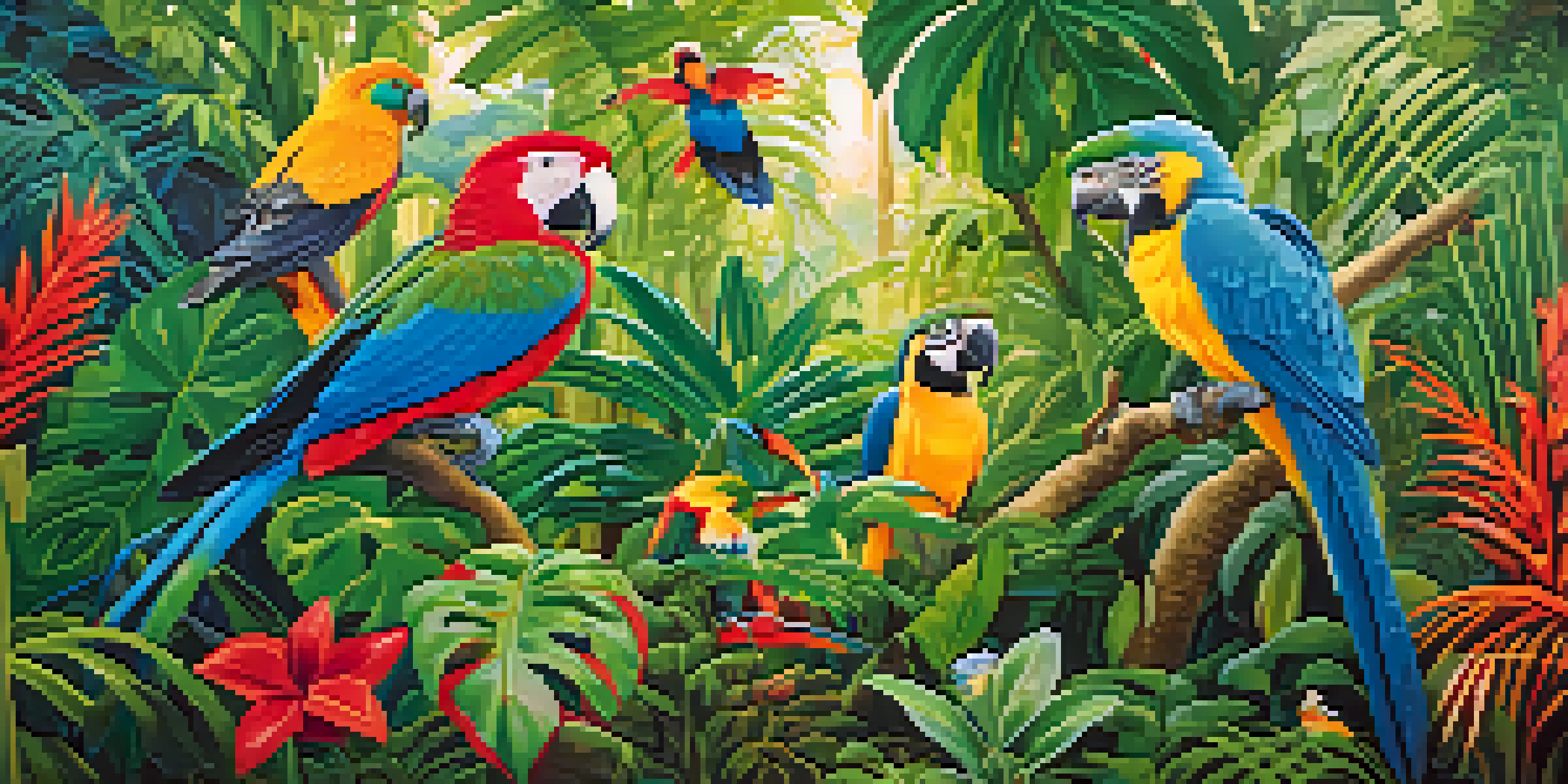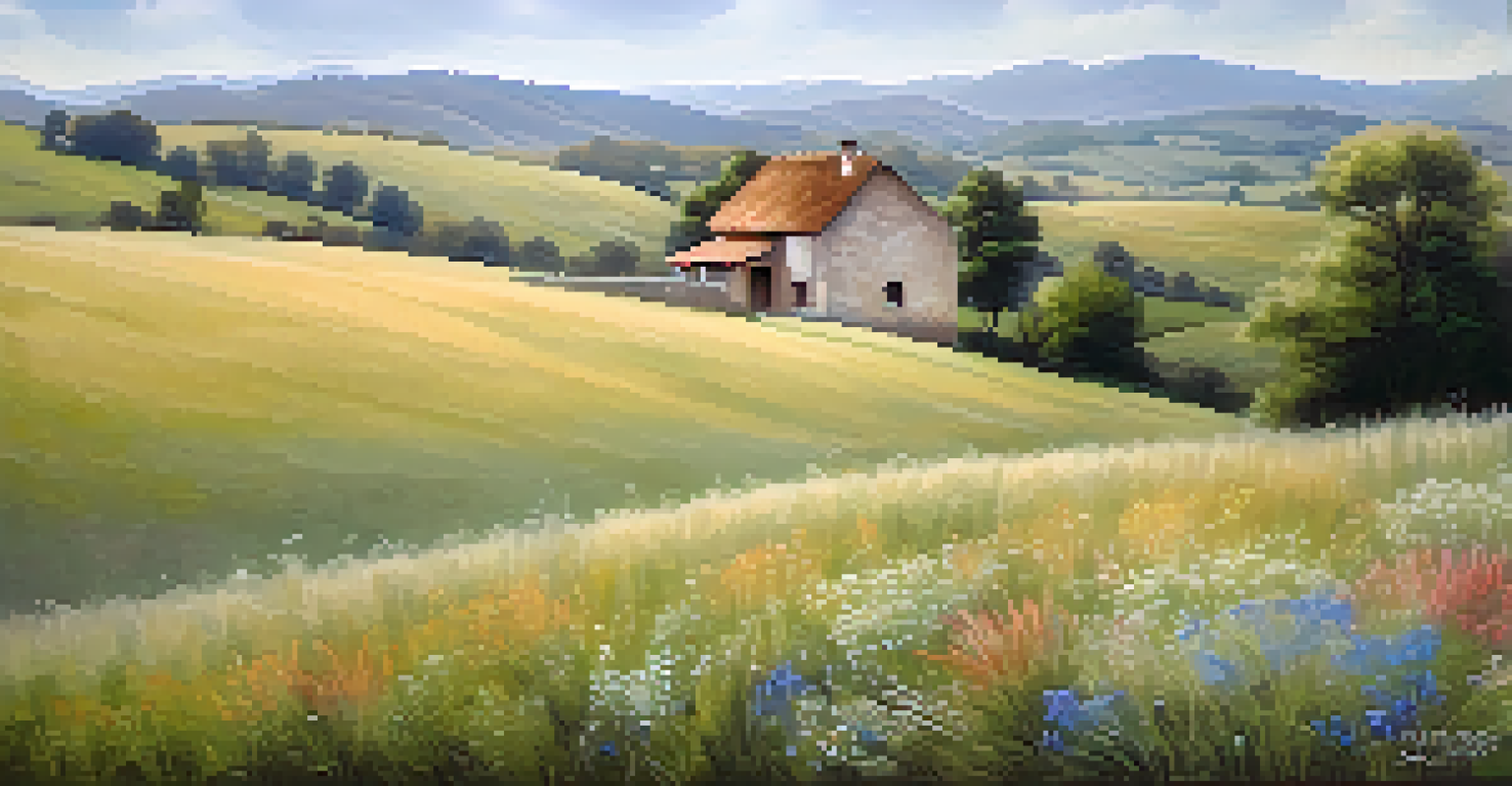Mural Painting Techniques: From Fresco to Spray Paint

Understanding Mural Painting: Definition and History
Mural painting is a form of visual art that involves creating large-scale artworks directly on walls or ceilings. This technique has roots that stretch back to ancient civilizations, such as the Egyptians and the Greeks, who used murals to tell stories and convey cultural values. Over the centuries, murals have evolved, adapting to new artistic styles and societal changes.
Art is not what you see, but what you make others see.
Historically, murals served not only as decoration but also as a means for social commentary and political expression. For instance, during the Mexican Mural Movement in the early 20th century, artists like Diego Rivera used murals to address social issues and celebrate Mexican heritage. Today, this art form continues to thrive, with street art and public installations becoming more prevalent.
Understanding the history of mural painting helps us appreciate the cultural significance and artistic depth behind the works we see today. From ancient frescoes to contemporary street art, murals remain a powerful medium for storytelling and community engagement.
Fresco Painting: The Timeless Technique
Fresco painting is one of the oldest mural techniques, dating back to ancient Rome. This method involves applying water-based pigments onto freshly laid wet plaster, allowing the colors to bond with the wall as it dries. The result is a durable and vibrant artwork that can withstand the test of time, as seen in the masterpieces of Michelangelo in the Sistine Chapel.

One of the challenges of fresco painting is the need for speed and precision; once the plaster sets, the artist has limited time to apply their colors. This technique requires a deep understanding of color theory and composition, as mistakes can be difficult to correct. Despite these challenges, the beauty and longevity of frescoes make them a revered choice for many artists.
Mural Painting: A Cultural Legacy
Mural painting has a rich history, evolving from ancient civilizations to modern street art, serving as a powerful medium for storytelling and social commentary.
Fresco painting is not just about technique; it also embodies a deep connection to the surface it adorns. Artists often create scenes that reflect the surrounding environment, making frescoes a harmonious part of their settings.
Tempera Painting: The Bright and Bold Choice
Tempera painting is another traditional technique that uses pigments mixed with a water-soluble binder, such as egg yolk. This method allows for vibrant colors and fine details, making it a popular choice for muralists who want to create intricate designs. Tempera dries quickly, which means artists must work efficiently to blend colors and achieve the desired effects.
The greatest artist is not necessarily the one who produces the greatest work, but the one who inspires the most creativity in others.
Unlike fresco, tempera can be applied to dry plaster, giving artists more flexibility in their working conditions. This accessibility has led to its use in various cultural contexts, from Byzantine icons to Renaissance artworks. The versatility of tempera allows for stunning results that can bring a mural to life.
Many contemporary artists still embrace tempera for its rich, matte finish and ease of use. This technique allows for a unique aesthetic that can enhance the storytelling aspect of murals, making them even more engaging for viewers.
Acrylics: The Modern Muralist's Favorite
Acrylic paint has revolutionized mural painting with its vibrant colors, quick drying time, and ease of use. This medium can be applied to a variety of surfaces, making it incredibly versatile for muralists. Artists can layer colors seamlessly, creating depth and texture that can make murals pop.
One of the significant advantages of acrylics is their durability; they are resistant to fading and can withstand exposure to the elements. This quality makes acrylics a preferred choice for outdoor murals, which are exposed to sunlight, rain, and other environmental factors. As a result, many urban artists opt for acrylics to ensure their work remains vibrant over time.
Techniques Shape Mural Artistry
Different painting techniques, such as fresco, tempera, and acrylics, each offer unique benefits and challenges that influence the outcome and longevity of murals.
Additionally, the range of acrylic products available, from spray paints to heavy-bodied paints, allows artists to experiment with different techniques and styles. This adaptability has made acrylics a staple in the modern muralist's toolkit.
Spray Paint: The Urban Art Revolution
Spray paint has become synonymous with street art and urban murals, offering a dynamic and expressive way to create large-scale artworks. This technique allows artists to quickly cover large areas and create intricate designs with ease. The portability and convenience of spray paint have made it a favorite among graffiti artists and muralists alike.
The rise of spray paint as a legitimate art form has transformed urban landscapes around the world. Artists like Banksy have popularized this medium, showcasing how spray paint can convey powerful messages and social commentary. The immediacy of spray paint allows for spontaneous creativity, often resulting in murals that resonate deeply with communities.
However, it's essential to note that the use of spray paint in public spaces must be approached responsibly. Many cities have embraced mural festivals and legal walls to promote artistic expression while ensuring that the work is appreciated rather than vandalized.
Mixed Media: Combining Techniques for Unique Murals
Mixed media murals involve the use of various materials and techniques to create a cohesive artwork. Artists might combine acrylics, spray paint, and even traditional methods like fresco or tempera to achieve unique effects and textures. This versatility allows for greater creativity, pushing the boundaries of traditional mural art.
By incorporating different materials, artists can create depth and dimension in their work, making murals more engaging to viewers. For instance, using collage elements or textured surfaces can enhance the storytelling aspect of a mural, inviting viewers to engage with the piece on multiple levels.
Future Trends in Mural Creation
Innovations like augmented reality and eco-friendly practices are emerging in mural painting, enhancing viewer engagement and promoting sustainability.
The mixed media approach also reflects the diversity of urban environments, where murals often incorporate elements from the surrounding culture and community. This technique allows artists to tell richer stories and connect more deeply with their audiences.
Choosing the Right Technique for Your Mural Project
When embarking on a mural project, selecting the right technique is crucial to achieving your artistic vision. Factors such as the mural's location, surface type, and intended message all play a role in this decision. For example, a vibrant street mural might benefit from spray paint, while a community center could be a great fit for a more traditional fresco.
It's also essential to consider the longevity and maintenance of the mural. Techniques like acrylics and spray paint offer durability for outdoor installations, while tempera may be better suited for indoor projects. Understanding the characteristics of each method can help artists make informed choices that align with their goals.

Ultimately, the best technique for your mural project will depend on your unique vision and the story you want to tell. Don't be afraid to experiment and blend techniques to create a one-of-a-kind masterpiece that resonates with your audience.
The Future of Mural Painting: Trends and Innovations
As mural painting continues to evolve, artists are exploring new trends and innovations that push the boundaries of this art form. Technologies like augmented reality (AR) are starting to influence murals, allowing viewers to interact with the artwork in exciting new ways. Imagine standing in front of a mural that comes to life through your smartphone, providing a deeper narrative experience.
Sustainability is another growing trend in mural painting, with artists using eco-friendly materials and practices to create their works. This shift reflects a broader awareness of environmental issues and a commitment to creating art that respects the planet. Artists are also exploring ways to incorporate natural elements into their murals, blending art with nature.
The future of mural painting promises to be vibrant and dynamic, with new techniques and technologies shaping the landscape. As artists continue to experiment and innovate, we can expect to see murals that not only beautify spaces but also tell powerful stories and engage communities in meaningful ways.